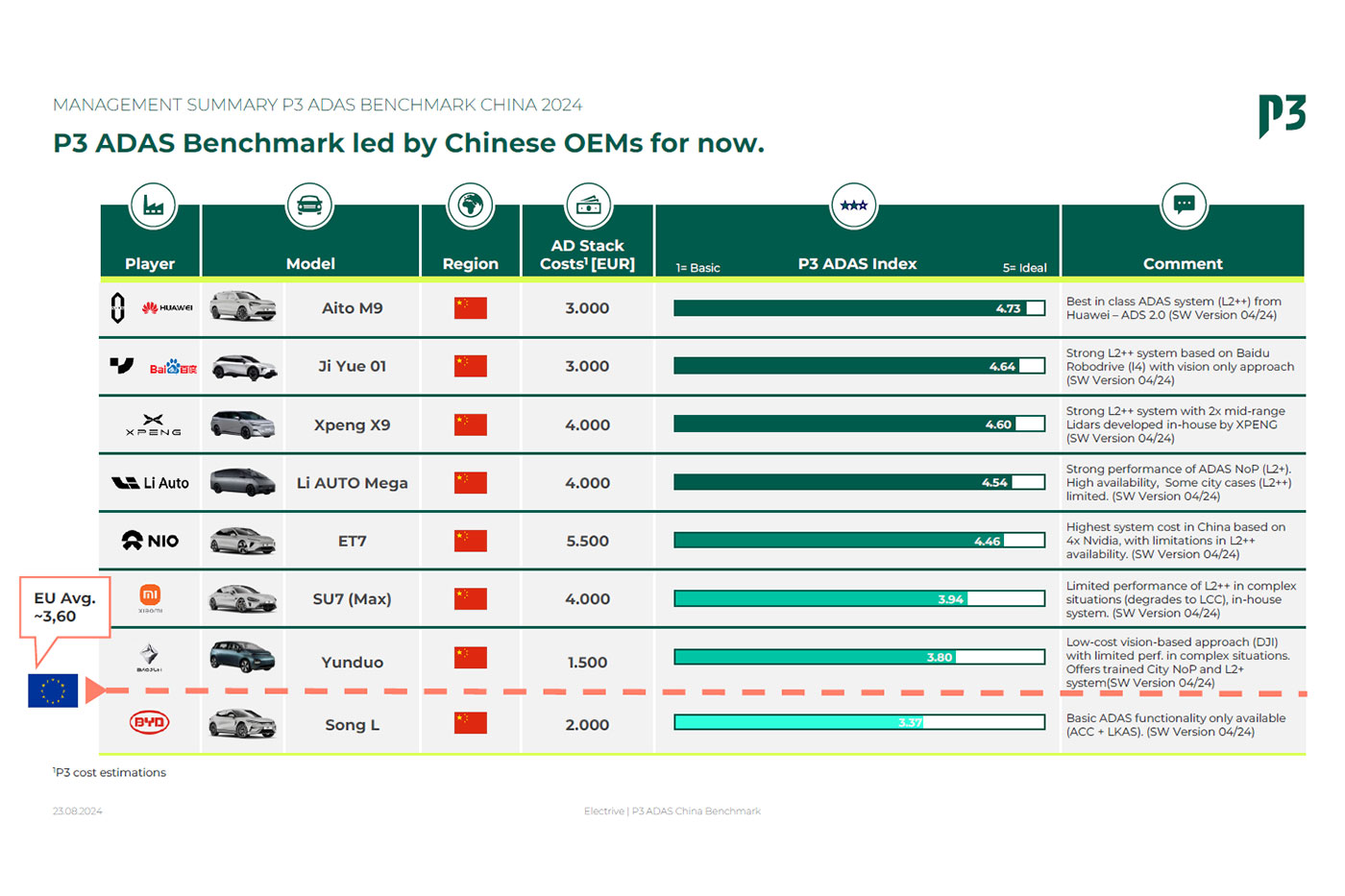
P3 ADAS Benchmark – China Edition: Huawei’s system takes the lead
P3 organised its two-day ‘Car Experience Event’ as part of the Beijing Auto Show in April this year. Almost 70 customers accepted the invitation. A total of eight vehicles were available for test drives. Nearly all test cars had a Level 2++ feature, specifically the ‘Navigation on Pilot’ (NoP) function in the city (exceptions: Baojun Yunduo with L2+ and BYD Song L with L2).
To clarify: Level 2+/2++ goes beyond the usual Level 2 systems by enabling advanced assistance functions such as hands-free driving under certain conditions – for example, in clearly defined areas such as motorways (L2+) or the city (L2++). The regulations in China do not actually allow hands-free driving. However, Chinese manufacturers rely on comparatively generous time windows in which the driver is asked to take over the steering wheel. It gives the impression that the vehicle can drive autonomously for several minutes. However, as with all L2, L2+ and L2++ systems, the responsibility remains entirely with the driver.
The P3 ADAS Index
The evaluation and comparison of ADAS is a major challenge in the automotive industry. Despite the increasing prevalence and importance of ADAS functions, there is a lack of clearly defined KPIs and standardised evaluation methods. This gap leads to uncertainty among consumers, manufacturers and regulators, who find it difficult to assess the performance and benefits of ADAS. P3 has developed the ADAS Index to solve precisely this problem. Using a standardised framework and over 100 specific test cases, the P3 ADAS Index provides an objective and traceable assessment of ADAS performance across all function clusters (driving, parking and safety) up to and including SAE Level 3.
P3 has set itself the goal of creating transparency and comparability in this complex field to promote the development of safe and efficient driver assistance systems. The P3 ADAS Index helps both industry and consumers make informed decisions while supporting the advancement of these critical technologies. It takes into account the categories of performance, comfort, safety, usability and perception to provide a comprehensive and meaningful overall picture.
How well and how reliably do the systems work?
The vehicles could carry out complex manoeuvres, from automated left and right turns to lane changes – even in very dense traffic scenarios. The ADAS systems of all the test cars were ultimately convincing in both the city and on the motorway. Tests were conducted in the driving, parking and on-board safety function clusters.
Incidentally, Chinese OEMs achieve a high level of confidence in the systems here, as they show a detailed display of the surrounding situation in the HMI displays and provide constant audio feedback on intended and upcoming manoeuvres.
Winners and losers in the P3 ADAS Index
The scale of the P3 ADAS Index ranges from 1 (basic) to 5 (ideal) – with the European average being 3.6. The Aito M9, which uses Huawei technology, secured the top spot in the index with a 4.73. The Ji Yue 01 (4.64) and the Xpeng X9 (4.60) follow in second and third place. Only the BYD Song L with its L2 came in at 3.37 – below the European average.

In an international comparison, Chinese OEMs clearly lead the P3 ADAS Benchmark. That makes it very difficult for global OEMs to compete in the Chinese market. In addition, international manufacturers are not expected to launch Level 2+ functions on the Chinese market before the end of 2025.
The results of the P3 ADAS Index are, of course, a snapshot in time – the driving functions are constantly evolving thanks to regular software updates. In the test, for example, the Aito M9 was travelling with ADS 2.0. It has now launched ADS 3.0. Nevertheless, there are signs of a fundamental trend in the performance of Chinese players. With this in mind, P3 plans to carry out such tests regularly and monitor technical developments.
Market outlook
In the increasingly competitive environment with regard to ADAS and charging performance, Chinese OEMs are likely to secure further market share in the domestic NEV market. And, of course, Chinese manufacturers are also looking to Europe – where, in addition to special tariffs, further regulatory hurdles concerning cyber security and functional safety await.
Established Chinese technology companies such as Huawei and Baidu are driving progress in ADAS performance and cooperation with international OEMs (Baidu & Tesla, VW & Xpeng). As a result, EU Tier 1 suppliers such as Bosch are losing ground.
“Overall, European car manufacturers are currently at least two years behind their Chinese competitors in terms of development,” summarises Marco Dargel, Partner at P3.”It makes the race for leadership in the all-important driver assistance systems and software in China challenging for German and international OEMs and established suppliers.”
Chinese technology companies and startups such as Horizon Robotics, Black Sesame, Phigent Robotics and Robosense are not standing still either.
With important new products and technologies (lidar, low-cost camera solutions, SoC), they will likely become increasingly valuable partners for OEMs, enabling them to improve their product range. “China must now be seen as a lead market to increase the speed of development through targeted cooperation,” concludes Dargel.
Source: P3 ADAS Benchmark – China




1 Comment